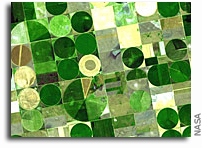NASA's Underserved Sectors of America

Media Invited to Talk Tech with NASA Administrator at World Ag Expo, NASA
“NASA Administrator Jim Bridenstine will speak to, and take questions from, media about how technologies originally developed for space exploration now are used to cultivate farms, predict crop yields, manage water resources, and more, during his Tuesday, Feb. 12, visit to World Ag Expo in Tulare, California.”
Space Station Flyovers In Flyover Country Are Not All That They Could Be, earlier post
“In 2016 people talked about “flyover country” without giving it too much thought as to what it meant other than that’s where Trump voters and/or Hillary haters lived. You’ve all heard me rant about how I think NASA needs to readjust its education and public outreach efforts so as to reach the large sectors of America that do not usually get NASA’s attention. In my mind there is some overlap between the flyover country meme and what I consider to be a chronically underserved portion of America’s population when it comes to NASA outreach.”
Doing Something Again For The First Time, earlier post
“Take a look at the chart below. More than half of the Americans alive today never saw humans walk on the Moon – as it happened – including the person slated to become the next administrator of NASA and the entire 2013 and 2017 astronaut classes. If/when we go back to the Moon in the next 5-10 years this number will increase. For them these future Moon landings will be THEIR FIRST MOON LANDINGS. That’s several hundred million Americans waiting to see what I saw in 1969. Just sayin’









Not sure what you mean by “underserved” as folks in agriculture in rural America are probably far more aware of the value of NASA in their daily lives than most city dewellers. I know first hand as I teach in a university in a small (15,000) town in rural Texas. You would be amazed at how many times you will walk into an office or school and see a picture of the community from space. GPS is built into most farm equipment (have you ever sat in a modern tractor? it looks like the inside of a space capsule with all its computer displays…) and the local communities are regular users of remote sensing data. It should also be noted that the majority of astronauts were born and raised in small towns in “flyover” country like the one I live in, perhaps because of both its close connection to space and because kids are actually able to see the stars and planets, as well as satellites from rural American.
BTW in the town I live in Pete Condrad’s son runs on of the ranches outside of town, and I am friends with a retired NASA engineer who organizes star parties at the local schools. And just down the road in the next town the parents of a retired shuttle astronaut live.
By contrast in big cities, given the pollution and smog, few stars are visible to the residents there. Tell me, when was the last time you were able to stop along the road to look at the glory of the Milky Way? And let’s face it, the average city person has little need for remote sensing or GPS since they ride public transit and make their living in an office. So perhaps its the big coastal cities like NY and Washington that are really beimg underserved by NASA…
>given the pollution and smog, few stars are visible to the residents there
Interesting mention, let me add as a city dweller there is no reason to look up into the sky. Only see the same 23 stars.
>city person has little need for remote sensing or GPS
There are city people that rely on GPS to get around town, I don’t need it because maps and road signs. Most of the money for remote sensing systems and GPS comes from city dwellers (majority of tax payers), however, rural and city folk are no better than the other as we are all interconnected. Farming gets their money from city folk. But food comes from farms, not supermarkets.
Brad Parkinson and James Spilker, Jr. (both worked on early GPS) at 2007 Engineers Week Banquet said back in 1970s they never thought GPS would be used by farming in such a large scale and to the precision that is done these days.